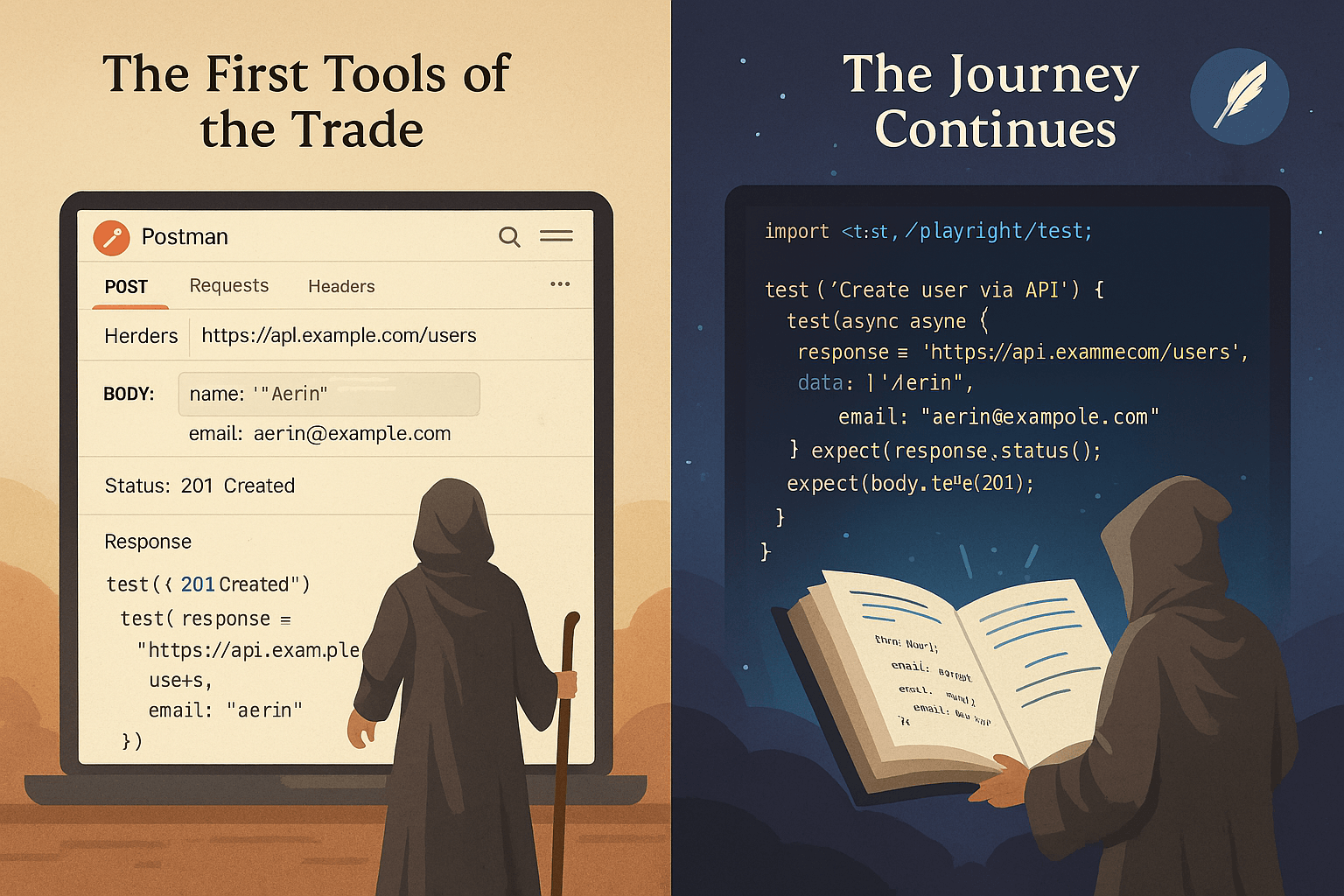From Postman to Playwright: A Tester’s Journey into API Automation
Mirada Gunasekara
18 Jun, 2025

First Tools of Trade
First Tools of Trade
Every journey begins with a simple task. In this case, it’s ‘testing an API’. There’s no interface, no buttons to click, just an endpoint, some data, and a response to verify.
That’s where Postman entered the scene.
For many, it has become their first real hands-on experience with backend testing. It’s intuitive and incredibly beginner-friendly. You create a request, send it off, and receive a clear response. Everything feels organised and under control.
Postman helps people work with APIs. Testers and developers can send requests and see responses, which helps them understand how data is sent and received. They learn what makes an endpoint work and what causes it to fail. In the beginning, just being able to test and see results is enough.
Repetition Sets In…
Repetition Sets In…
But the workload shifts as the system grows with more features, services, and environments.
Suddenly, the same set of API tests needs to be run manually for every release.
- Creating a new user
- Logging in
- Checking the response payload
- Validating status codes
What was once a curious exploration becomes routine. Click, send, check, repeat. It’s efficient but far from scalable. With every new build, the manual effort begins to feel heavier.
The explorer now stands at a crossroads: continue with the current tools or seek a better way to scale?

The Discovery of Automation
The Discovery of Automation
The search for efficiency leads to something familiar but often overlooked: Playwright. While Postman is great for testing individual API calls, Playwright goes further by testing how those APIs work in real browsers and real user flows. It’s not just about sending requests, it’s about seeing how the whole system behaves, end to end. Many people already know about it, but don’t think to use it for API testing.
Known widely for UI testing, Playwright has a hidden power: native support for API testing. It doesn’t need plugins or extensions. It doesn’t require switching contexts or tools. It just works right alongside the existing tests.
This shift doesn’t feel like learning a brand-new tool. It feels more like unlocking a new ability.
The First Steps into Code
The First Steps into Code
The first automated API test in Playwright is simple but powerful:
1import { test, expect, request } from '@playwright/test';2 3 test('Create user via API', async ({ request }) => {4 const response = await request.post('https://api.example.com/users', {5 data: {6 name: 'Aerin',7 email: 'aerin@example.com'8 }9 });10 11expect(response.status()).toBe(201);12const body = await response.json();13expect(body).toHaveProperty('id');14});This has no UI requirement, no clicking, and no visual interface. Just code that runs fast, validates itself, and can be reused and scaled.
With each test added, confidence grows. What once required minutes of manual effort now runs automatically in seconds.
Expanding the Test World
Expanding the Test World
As tests grow in number and complexity, Playwright stands out with features more than basic API testing:
- Built-in HTTP methods like GET, POST, PUT, and DELETE
- Fixtures to handle setup and teardown
- Global hooks for token management
- Support for chaining requests or combining API + UI in one suite
- Parallel execution for speed
- CI/CD integration for continuous validation
Soon, tests will be doing more than just hitting endpoints. They’re building workflows instead of;
- Register a new user via API
- Authenticate and receive a token
- Verify the dashboard via UI
- Clean up test data all in one go
Reflection and Evolution
Reflection and Evolution
Looking back, Postman played a major role. It was the spark that introduced the world to APIs. It made learning simple, fast, and visual. It served its purpose as a testing ground for new ideas and quick debugging.
But the journey can’t stay in one place forever.
Automation tools like Playwright offer what’s needed for the next step:
- Speed
- Scalability
- Structure
They don’t replace curiosity; they reward it with more power.
The Journey Continues
The Journey Continues
Every tester eventually reaches a turning point where manual testing starts to limit progress, and clicking “Send” in Postman no longer matches the pace of the development cycle. One line of automated code begins to replace five minutes of repetition.
But before automation takes full control, it’s important to acknowledge that Postman, too, has evolved. It's more than just a manual testing tool now. For testers not ready to fully dive into code-based frameworks like Playwright, Postman offers several powerful features that support scalable, automated workflows:
- Pre-request and Test Scripts: Automate request flows and validate responses using JavaScript.
- Environment Variables: Easily switch between dev, staging, and prod.
- Collection Runner and Monitors: Run test suites on schedule or via CI with Newman.
- Mock Servers and Docs: Simulate APIs and auto-generate documentation.
- CI Integration: Works with Jenkins, GitHub Actions, and more for regression checks in pipelines.
These advanced features extend Postman’s life far beyond basic testing. They allow for semi-automated pipelines, faster feedback loops, and collaborative testing across teams.
Still, as systems grow and testing demands scale further, the shift toward fully code-based tools like Playwright feels natural.
Playwright offers a more unified ecosystem, combining API and UI testing, custom scripting, reusable logic, and tight integration with modern development practices.
To Wrap Up...
To Wrap Up...
In the end, it's not a choice between Postman or Playwright; it’s a journey through both. Postman teaches the fundamentals and supports advanced testing workflows, while Playwright unlocks full automation, CI/CD integration, and test orchestration at scale.
What starts with clicking "Send" may end in continuous, intelligent testing.
And that’s where the real journey begins.

More about the author:
Mirada Gunasekara
Mirada is a Quality Engineering Intern and a 4th year Computer Science undergraduate at NSBM Green University. She is an ISTQB Certified Tester with a strong passion for software quality, working across both manual and automated testing. With hands-on experience in tools like Playwright, Postman, and Selenium, she is continuously learning and evolving to build a successful career in Quality Engineering.